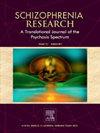与卫生服务机构接触不良童年经历和随后的非情感性精神障碍风险:来自加拿大安大略省的基于人群的证据
IF 3.5
2区 医学
Q1 PSYCHIATRY
引用次数: 0
摘要
目的:利用基于人群的健康管理数据,评估儿童不良经历(ace)卫生服务接触指标与精神障碍风险之间的关系。方法我们使用基于人群的健康管理数据构建安大略省- minds队列。该队列包括1992年至1996年出生的儿童,与孕产妇健康记录相关,并随访至27-31岁,使用经过验证的算法确定事件非情感性精神障碍(NAPD)。我们进行了一项范围审查,以确定指示12岁之前与ace相关的卫生服务接触的代码,包括虐待、忽视和家庭功能障碍的指标。估计多变量修正泊松回归模型以获得发病率比(IRR)和95%置信区间(CI)。结果分析样本(559,073)中,27.1%的人曾接触过一次或多次ace。有家庭功能障碍接触者患NAPD的风险高51% (IRR = 1.51;95%CI = 1.45,1.58),有虐待/忽视接触者患NAPD的风险高78% (IRR = 1.78;95%CI = 1.58,2.01),有家庭功能障碍和虐待/忽视卫生服务接触者患NAPD的风险高近三倍(IRR = 2.61;95%CI = 2.38,2.85)。我们还发现了梯度效应,4+ ACE亚型的卫生服务接触者患NAPD的风险显著升高(IRR = 4.04;95%CI = 3.26,5.01),相对于无ace相关接触者。结论我们的研究结果为越来越多的文献提供了基于人群的证据,表明ace对严重精神障碍的有害影响,并突出了行政数据库在推进该领域研究中的作用。本文章由计算机程序翻译,如有差异,请以英文原文为准。
Contact with health services for adverse childhood experiences and subsequent risk of non-affective psychotic disorder: Population-based evidence from Ontario, Canada
Objective
We sought to estimate the association between indicators of health service contact for adverse childhood experiences (ACEs) and the risk of psychotic disorders using population-based health administrative data.
Methods
We accessed the Ontario-MINDS cohort, constructed using population-based health administrative data. The cohort included children born between 1992 and 1996, linked to maternal health records, and followed to age 27–31 years to identify incident non-affective psychotic disorder (NAPD) using a validated algorithm. We conducted a scoping review to identify codes indicative of ACE-related health service contacts prior to age 12 years, including indicators of abuse, neglect, and household dysfunction. Multivariable modified Poisson regression models were estimated to obtain incidence rate ratios (IRR) and 95 % confidence intervals (CI).
Results
In our analytic sample (n = 559,073), 27.1 % had a health service contact for one or more ACEs. The risk of NAPD was 51 % higher for those with a contact for household dysfunction (IRR = 1.51;95%CI = 1.45,1.58), 78 % higher for those with a contact for abuse/neglect (IRR = 1.78;95%CI = 1.58,2.01), and nearly three-fold higher among those who had health service contacts for both household dysfunction and abuse/neglect (IRR = 2.61;95%CI = 2.38,2.85). We also found a gradient effect, and people with health service contacts for 4+ ACE subtypes had a substantially elevated risk of NAPD (IRR = 4.04; 95%CI = 3.26,5.01), relative to those with no ACE-related contacts.
Conclusions
Our findings add population-based evidence to the growing body of literature showing the detrimental effects of ACEs on serious mental disorders, and highlight the utility of administrative databases for advancing research in this field.
求助全文
通过发布文献求助,成功后即可免费获取论文全文。
去求助
来源期刊

Schizophrenia Research
医学-精神病学
CiteScore
7.50
自引率
8.90%
发文量
429
审稿时长
10.2 weeks
期刊介绍:
As official journal of the Schizophrenia International Research Society (SIRS) Schizophrenia Research is THE journal of choice for international researchers and clinicians to share their work with the global schizophrenia research community. More than 6000 institutes have online or print (or both) access to this journal - the largest specialist journal in the field, with the largest readership!
Schizophrenia Research''s time to first decision is as fast as 6 weeks and its publishing speed is as fast as 4 weeks until online publication (corrected proof/Article in Press) after acceptance and 14 weeks from acceptance until publication in a printed issue.
The journal publishes novel papers that really contribute to understanding the biology and treatment of schizophrenic disorders; Schizophrenia Research brings together biological, clinical and psychological research in order to stimulate the synthesis of findings from all disciplines involved in improving patient outcomes in schizophrenia.
 求助内容:
求助内容: 应助结果提醒方式:
应助结果提醒方式:


